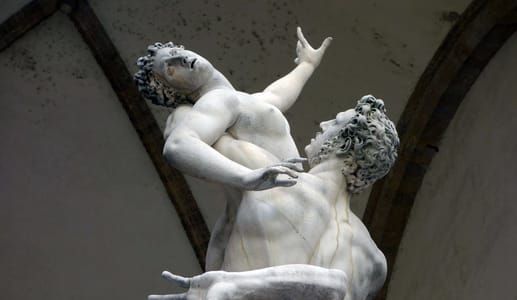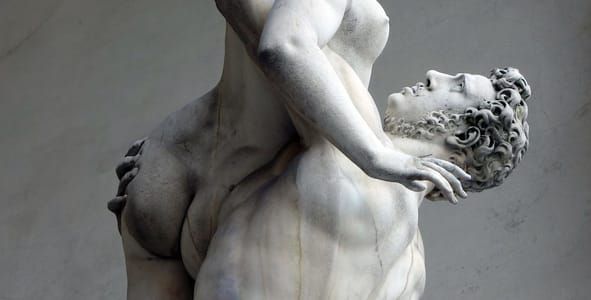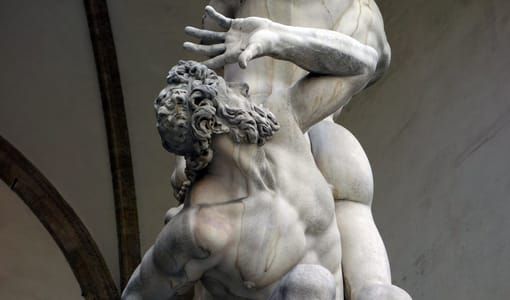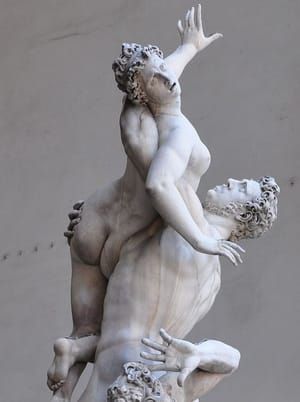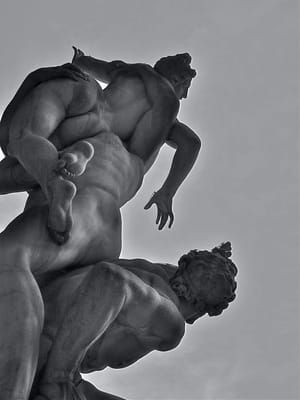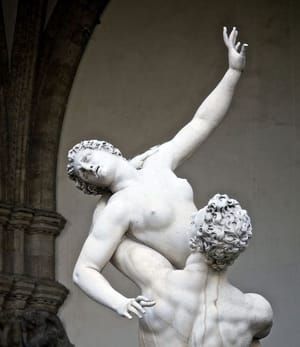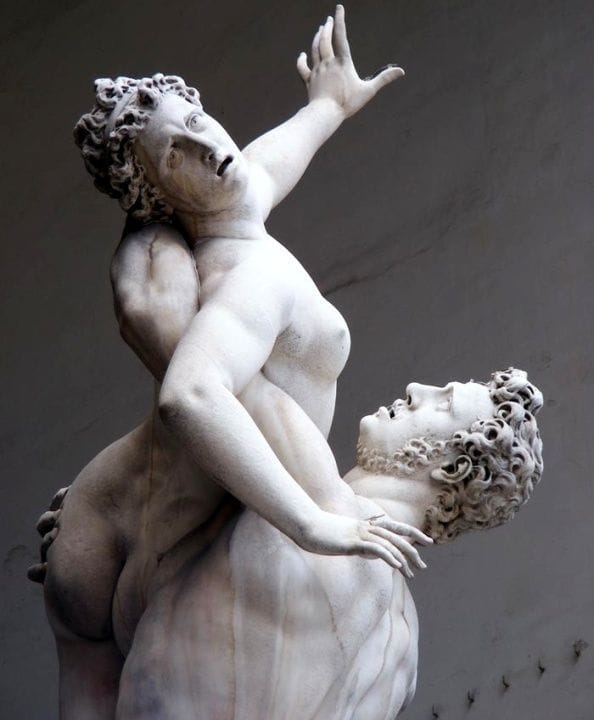

Rape of the Sabine Women
Giambologna
Carved from a single block of imperfect marble, the torturously twisting Rape of the Sabine Women in Florence’s Loggia dei Lanzi, Piazza della Signoria, is one of the finest and most technically difficult sculptures in the world. Three intertwined bodies, two men and a woman, spiral upwards as the woman tries to escape the clutches of the younger man standing over the older one. It is an absolute masterpiece by the Flemish sculptor Giambologna, and totally captivating...
Giambologna’s three figures represent a Sabine woman reaching heavenward for salvation from the young Roman kidnapper who stands astride a cowering, helpless older Sabine man, possibly the father of the woman.
…The statue is unusual for the fact that it can be viewed from any side. From one angle you see the Roman’s hand sink into the soft fleshy behind of the woman as he grapples with her. From another you see the anguish and panic on the woman’s face as she tries to wriggle free. And from yet another you see all three as their bodies knot and tangle together. There isn’t a boring angle. This piece is totally engrossing.
Previously, sculptures as complex as this had been carved in separate pieces and then connected together. That Giambologna used a single piece of marble to create the dynamic, complicated, intertwined spiral of bodies in different, almost unbalanced, positions was ground-breaking.
In truth, however, the sculpture wasn’t intended to represent the Roman-Sabine conflict and it doesn’t represent the rape of the women either.
Giambologna was originally just showing off his skill and dexterity by carving the sculpturally intricate and anatomically perfect piece. It wasn’t until his master, Grand Duke Francesco decided to display the 4m high masterpiece in the Piazza della Signoria, close to Michelangelo’s similarly glorious David finished 80 years earlier, that Giambologna hurriedly named it after another moment from mythology.
But Giambologna didn’t use the word rape. The original title was the Ratto delle Sabine, meaning the abduction of the Sabine. No sexual overtones were intended. Over time, however, the Italian name has been misinterpreted to mean rape as the words, ratto and rape, sounded similar. And so Giambologna’s audacity and ambition coupled with some quick-thinking naming has given us a statue depicting male aggression that still resonates today.
(https://dreamdiscoveritalia.com/2014/11/05/italian-art-101-the-rape-of-the-sabine-women-by-giambologna/)
The Kidnapping of the Sabine Women (Latin: Sabinae raptae) is an episode in the legendary history of Rome, traditionally dated to 750 BC, in which the first generation of Roman men acquired wives for themselves from the neighboring Sabine families. The English word rape is a conventional translation of the Latin raptio, which in this context means "abduction" rather than its prevalent modern meaning in English language of sexual violation. Recounted by Livy and Plutarch (Parallel Lives II, 15 and 19), it provided a subject for Renaissance and post-Renaissance works of art that combined a suitably inspiring example of the hardihood and courage of ancient Romans with the opportunity to depict multiple figures, including heroically semi-nude figures, in intensely passionate struggle. (https://en.wikipedia.org/wiki/The_Rape_of_the_Sabine_Women)
According to Plutarch, Romulus’ signal to the men of Rome was to be whenever he rose up to gather up his cloak and throw it over his body. When this signal was seen, the Romans were to fall on the Sabine maidens and carry them away. According to Plutarch, only virgins were abducted, with the exception of one Hersilia, who was a married woman. This, however, was said to be an accident. According to some historians, the abduction of the Sabines was not perpetrated out of lust, but out of a desire to form a strong alliance with them.
Instead of an alliance, however, the Romans ended up in a war with the Sabines, as they were obviously outraged that their women were forcibly taken by the Romans. After the allies of the Sabines were defeated, the Romans fought the Sabines themselves. By this time, the Sabine women had accepted their role as the wives of the Romans, and were quite distressed at the war between the two peoples. Finally, in one of the battles, the Sabine women stood between the Roman and Sabine armies, imploring their husbands on one hand, and fathers and brothers on the other to stop fighting. According to Livy, the Sabine women placed the blame for the war on themselves and said that they would rather die than to see bloodshed on either side of their families. Affected by their speech, the Romans and Sabines concluded a peace treaty, and the two peoples were united under the leadership of Rome, hence further strengthening the city of Rome. (http://www.ancient-origins.net/news-history/rape-sabine-women-002636 )
Uploaded on Nov 12, 2016 by Suzan Hamer
Giambologna
artistArthur
Wait what?




